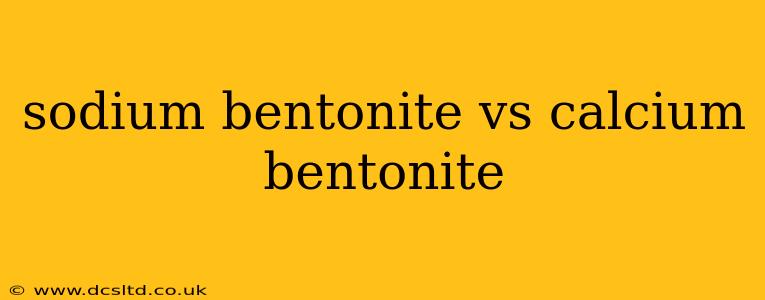Bentonite clay, a versatile material with numerous applications, comes in various forms, most notably sodium bentonite and calcium bentonite. While both originate from the same source – volcanic ash – their differing chemical compositions lead to significant variations in their properties and applications. Understanding these differences is crucial for choosing the right type for specific needs. This comprehensive guide delves into the key distinctions between sodium and calcium bentonite, helping you make informed decisions.
What is the difference between sodium and calcium bentonite?
The primary difference lies in the cation (positively charged ion) dominating the clay's structure. Sodium bentonite has sodium ions as the dominant cation, while calcium bentonite has calcium ions. This seemingly small difference significantly impacts their swelling capacity, viscosity, and overall performance characteristics.
How do their swelling capacities differ?
Sodium bentonite exhibits exceptionally high swelling capacity. When exposed to water, it can expand to many times its original volume, forming a gel-like substance. This property is crucial in applications requiring significant volume expansion and sealing capabilities. Calcium bentonite, on the other hand, has a much lower swelling capacity. Its expansion is considerably less dramatic compared to sodium bentonite.
Why does sodium bentonite swell more?
The sodium ions in sodium bentonite allow for greater hydration and dispersion of the clay particles. The weaker bond between the sodium ions and the clay layers permits water molecules to penetrate more easily, leading to substantial swelling. Calcium ions, being divalent (carrying a +2 charge), create stronger bonds, hindering water penetration and thus limiting swelling.
What are the viscosity differences?
Viscosity refers to a fluid's resistance to flow. Sodium bentonite forms higher viscosity fluids than calcium bentonite. This makes it ideal for applications requiring thick, stable suspensions. Calcium bentonite, due to its lower swelling capacity, creates lower viscosity fluids.
What are the main uses of each type?
The distinct properties of sodium and calcium bentonite dictate their applications:
Sodium Bentonite:
- Drilling muds: Its high swelling capacity and viscosity make it an essential component in drilling fluids, aiding in wellbore stability and cuttings removal.
- Waste containment liners: Its ability to swell and seal effectively makes it ideal for lining landfills and hazardous waste sites, preventing leakage.
- Animal feed: It is used as a binder and flow agent in animal feed.
- Cat litter: Its absorbency makes it a component in some cat litters.
- Foundry bonding: It's used as a binder in foundry sand.
Calcium Bentonite:
- Winemaking: It is used for clarifying wine and removing unwanted particles.
- Pill production: It acts as a binder and disintegrant in pharmaceutical tablets.
- Soil conditioning: Its cation exchange capacity can improve soil structure.
- Ceramics: It's used as a bonding agent and to improve the plasticity of clay bodies.
Which type of bentonite is better?
There's no single "better" bentonite; the optimal choice depends entirely on the specific application. If high swelling capacity and viscosity are required, sodium bentonite is preferred. For applications where lower viscosity or different cation exchange properties are needed, calcium bentonite may be more suitable.
Can calcium bentonite be activated to become more like sodium bentonite?
Yes, a process called sodium activation can modify calcium bentonite to enhance its swelling properties. This involves exchanging calcium ions with sodium ions, bringing its characteristics closer to those of sodium bentonite. However, this is a chemical process requiring specialized equipment and expertise.
What are the environmental considerations?
Both sodium and calcium bentonite are generally considered environmentally benign, but responsible sourcing and disposal practices are important. Avoid using bentonite from sources with potential contamination.
What is the cost difference?
Typically, sodium bentonite is slightly more expensive than calcium bentonite due to the processing required to achieve its higher sodium content and enhanced swelling capacity.
This comparison provides a comprehensive overview of sodium and calcium bentonite. Remember to consult with specialists for specific application guidance and to ensure the chosen bentonite aligns perfectly with your project requirements.
